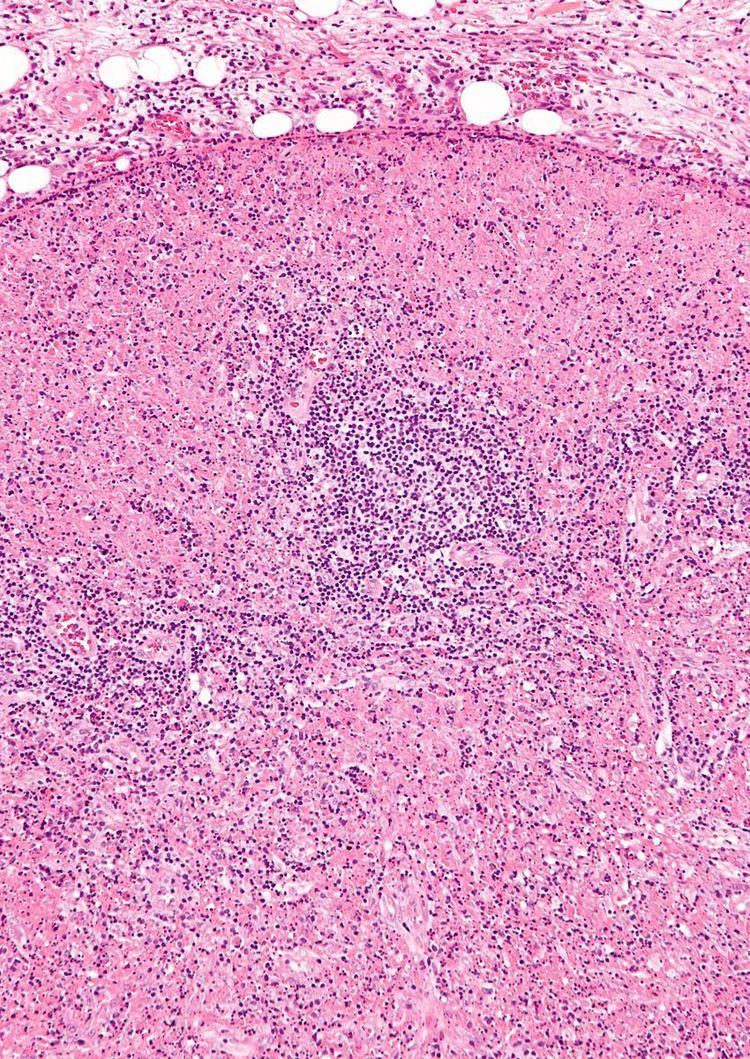eMedicine med/3663 | MeSH D020042 | |
 | ||
Kikuchi disease or Kikuchi-Fujimoto disease was described in 1972 in Japan. It is also known as histiocytic necrotizing lymphadenitis, Kikuchi necrotizing lymphadenitis, phagocytic necrotizing lymphadenitis, subacute necrotizing lymphadenitis, and necrotizing lymphadenitis.
Contents
It was first described by Dr Masahiro Kikuchi (1935–2012) in 1972 and independently by Y. Fujimoto.
Epidemiology
Kikuchi-Fujimoto disease (KFD) is a rare, self-limiting disorder that typically affects the cervical lymph nodes. Recognition of this condition is crucial, especially because it can easily be mistaken for tuberculosis, lymphoma, or even adenocarcinoma. Awareness of this disorder helps prevent misdiagnosis and inappropriate treatment.
Kikuchi's disease is a very rare disease mainly seen in Japan. Isolated cases are reported in North America, Europe, and Asia. It is mainly a disease of young adults (20–30 years), with a slight bias towards females. The cause of this disease is not known, although infectious and autoimmune etiologies have been proposed. The course of the disease is generally benign and self-limiting. Lymphadenopathy most often resolves over several weeks to six months. Recurrence rate is about 3%. Mortality is extremely rare and usually due to hepatic, respiratory, or cardiac failure.
Pathophysiology
Some studies have suggested a genetic predisposition to the proposed autoimmune response. Several infectious candidates have been associated with Kikuchi disease.
Many theories exist about the etiology of KFD. Microbial/viral or autoimmune causes have been suggested. Mycobacterium szulgai and Yersinia and Toxoplasma species have been implicated. More recently, growing evidence suggests a role for Epstein-Barr virus, as well as other viruses (HHV6, HHV8, parvovirus B19, HIV and HTLV-1) in the pathogenesis of KFD. However, many independent studies have failed to identify the presence of these infectious agents in cases of Kikuchi lymphadenopathy. In addition, serologic tests including antibodies to a host of viruses have consistently proven noncontributory and no viral particles have been identified ultrastructurally. KFD is now proposed to be a nonspecific hyperimmune reaction to a variety of infectious, chemical, physical, and neoplastic agents. Other autoimmune conditions and manifestations such as antiphospholipid syndrome, polymyositis, systemic juvenile idiopathic arthritis, bilateral uveitis, arthritis and cutaneous necrotizing vasculitis have been linked to KFD. KFD may represent an exuberant T-cell-mediated immune response in a genetically susceptible individual to a variety of nonspecific stimuli.
Human leukocyte antigen class II genes are more frequent in patients with Kikuchi disease, suggesting a genetic predisposition to the proposed autoimmune response.
Clinical features
The signs and symptoms of Kikuchi disease are fever, lymphadenopathy, skin rashes, and headache. Rarely, hepatosplenomegaly and nervous system involvement resembling meningitis are seen. Often a bout of extreme fatigue can occur - often taking hold during latter parts of the day and the patient can be more prone to fatigue from exercise. Differential diagnosis includes systemic lupus erythematosus (SLE), disseminated tuberculosis, lymphoma, sarcoidosis, and viral lymphadenitis. Clinical findings sometimes may include positive results for IgM/IgG/IgA antibodies.
For other causes of lymph node enlargement, see lymphadenopathy.
Diagnosis
It is diagnosed by lymph node excision biopsy.
Kikuchi disease is a self-limiting illness which has symptoms which may overlap with Hodgkin's lymphoma leading to misdiagnosis in some patients.
Antinuclear antibodies, antiphospholipid antibodies, anti-dsDNA, and rheumatoid factor are usually negative, and may help in differentiation from SLE.
Management
No specific cure is known. Treatment is largely supportive. NSAIDs are indicated for tender lymph nodes and fever, and corticosteroids are useful in severe extranodal or generalized disease.
Symptomatic measures aimed at relieving the distressing local and systemic complaints have been described as the main line of management of KFD. Analgesics, antipyretics, nonsteroidal anti-inflammatory drugs (NSAIDs), and corticosteroids have been used. If the clinical course is more severe, with multiple flares of bulky cervical lymphadenopathy and fever, then a low-dose corticosteroid treatment has been suggested.
